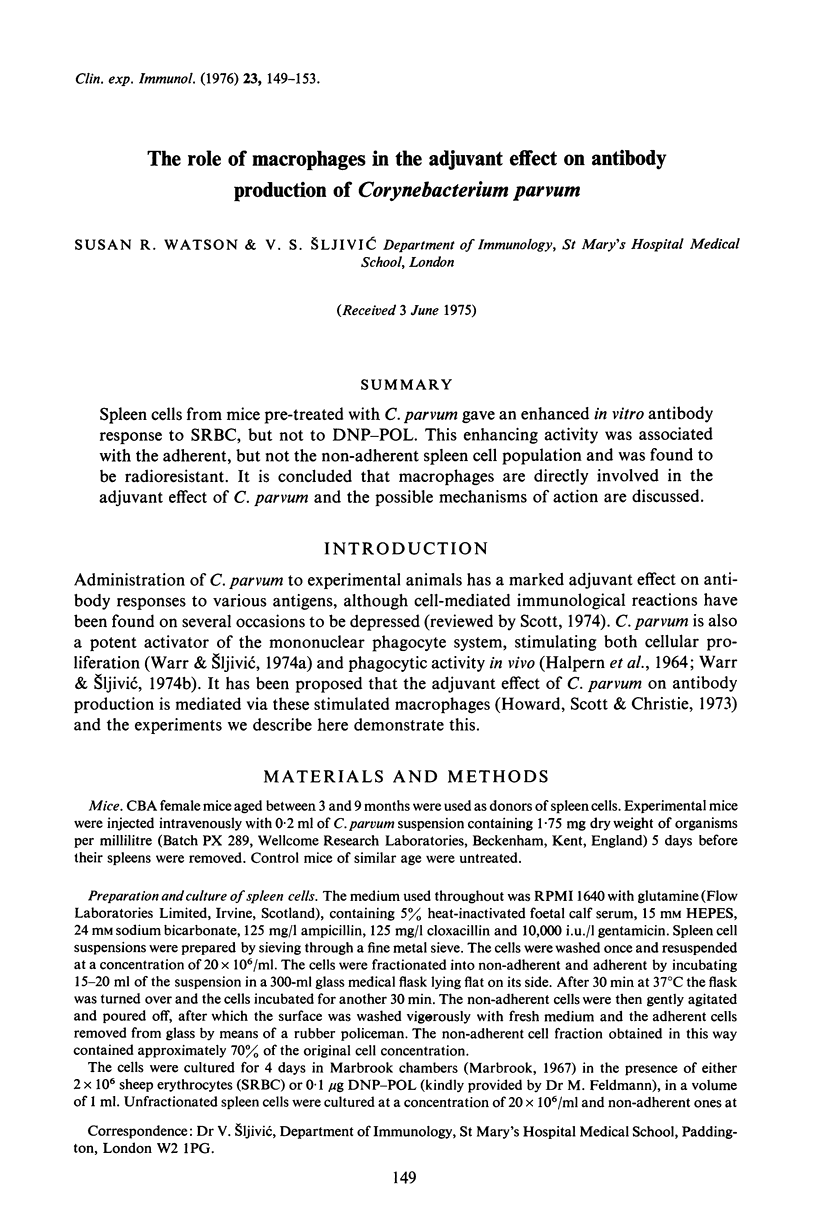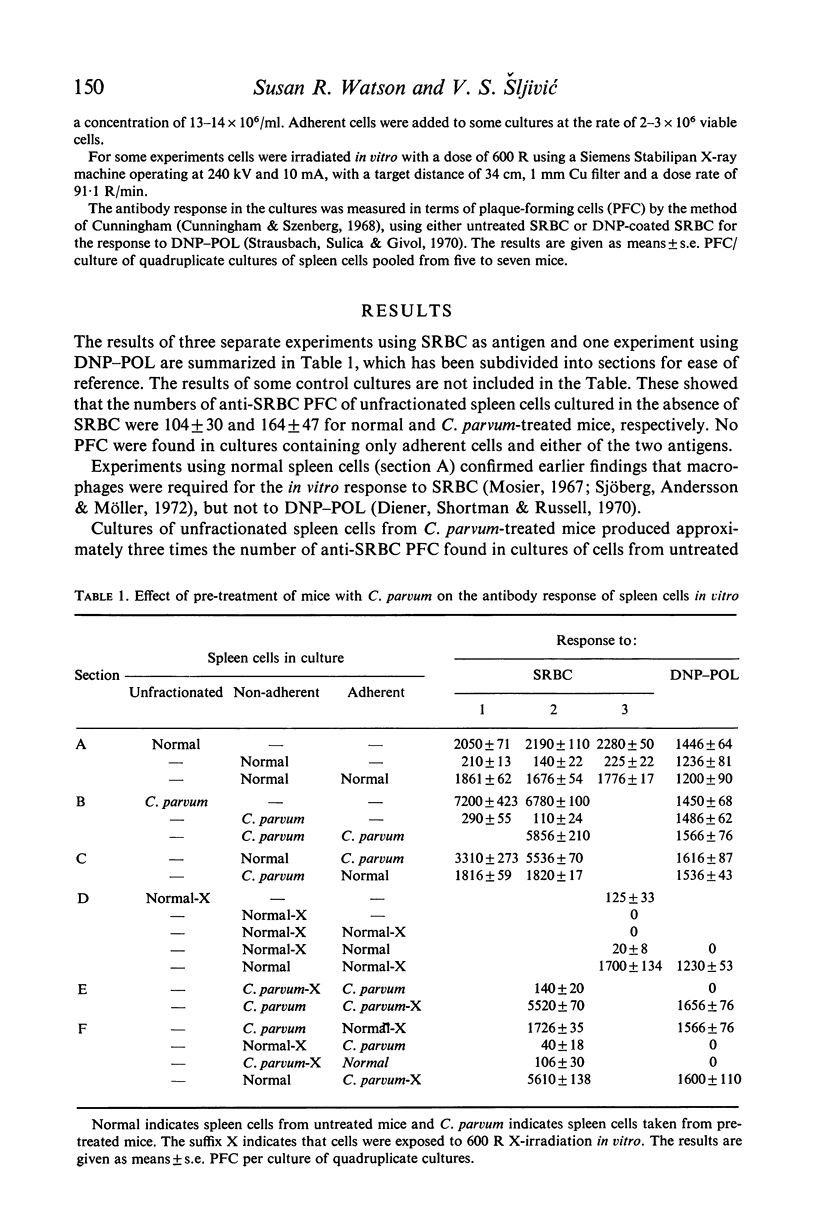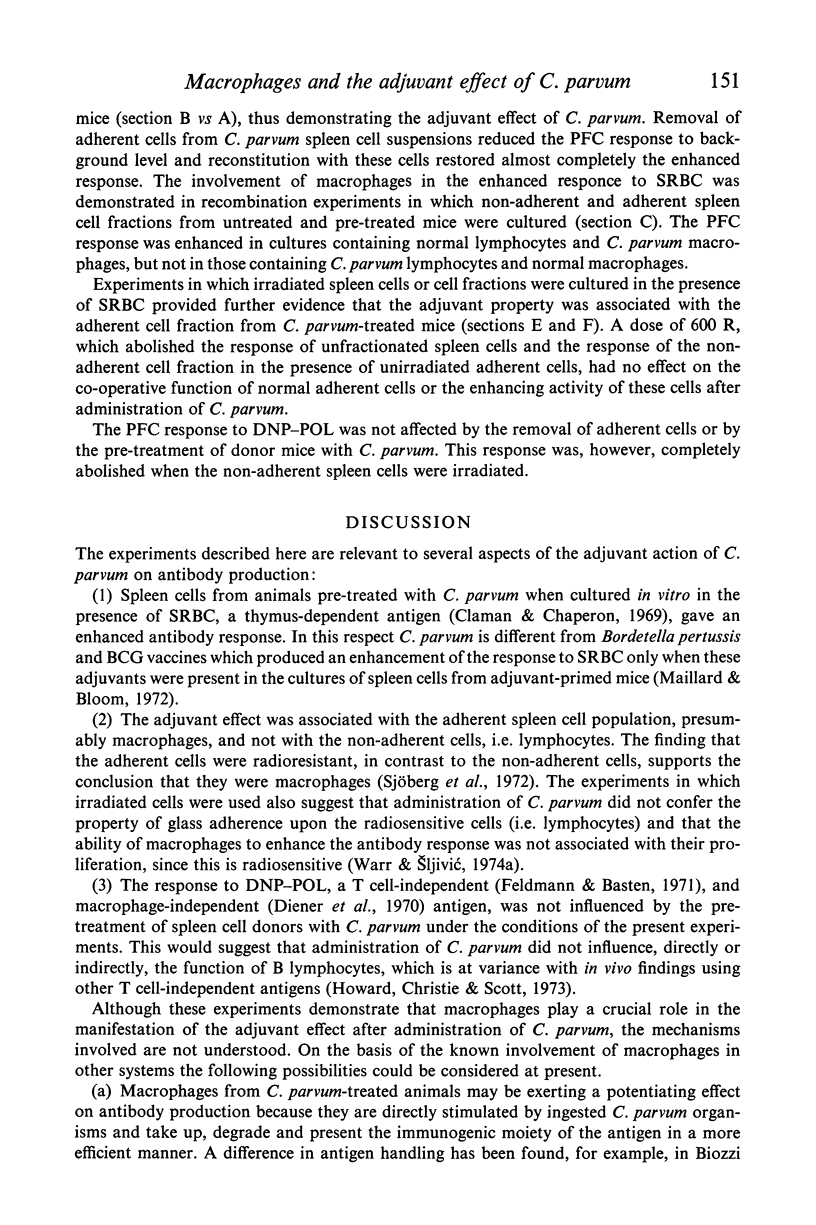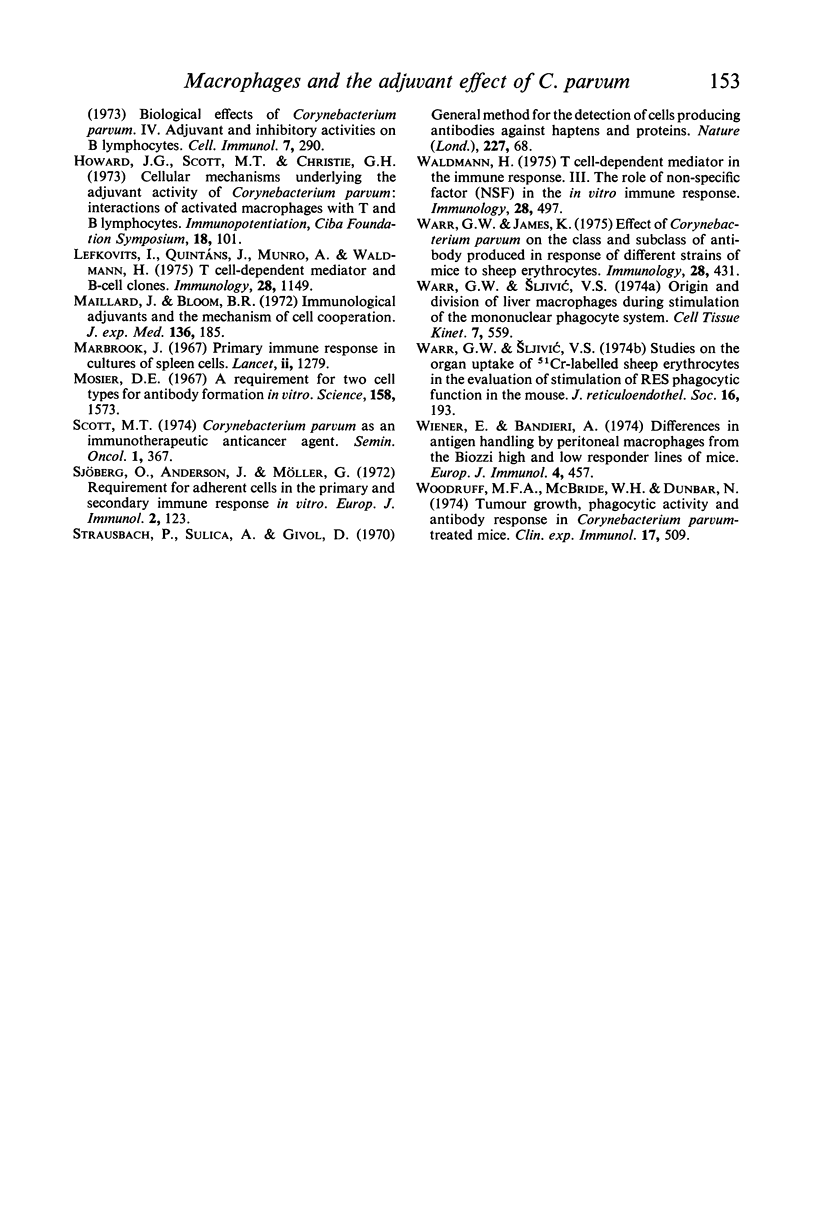Abstract
Spleen cells from mice pre-treated with C. parvum gave an enhanced in vitro antibody response to SRBC, but not to DNP-POL. This enhancing activity was associated with the adherent, but not the non-adherent spleen cell population and was found to be radioresistant. It is concluded that macrophages are directly involved in the adjuvant effect of C. parvum and the possible mechanisms of action are discussed.
Full text
PDF




Selected References
These references are in PubMed. This may not be the complete list of references from this article.
- Allison A. C., Davies A. J. Requirement of thymus-dependent lymphocytes for potentiation by adjuvants of antibody formation. Nature. 1971 Oct 1;233(5318):330–332. doi: 10.1038/233330a0. [DOI] [PubMed] [Google Scholar]
- Calderon J., Unanue E. R. Two biological activities regulating cell proliferation found in cultures of peritoneal exudate cells. Nature. 1975 Jan 31;253(5490):359–361. doi: 10.1038/253359a0. [DOI] [PubMed] [Google Scholar]
- Claman H. N., Chaperon E. A. Immunologic complementation between thymus and marrow cells--a model for the two-cell theory of immunocompetence. Transplant Rev. 1969;1:92–113. doi: 10.1111/j.1600-065x.1969.tb00137.x. [DOI] [PubMed] [Google Scholar]
- Cunningham A. J., Szenberg A. Further improvements in the plaque technique for detecting single antibody-forming cells. Immunology. 1968 Apr;14(4):599–600. [PMC free article] [PubMed] [Google Scholar]
- Diener E., Shortman K., Russell P. Induction of immunity and tolerance in vitro in the absence of phagocytic cells. Nature. 1970 Feb 21;225(5234):731–732. doi: 10.1038/225731a0. [DOI] [PubMed] [Google Scholar]
- Feldmann M., Easten A. The relationship between antigenic structure and the requirement for thymus-derived cells in the immune response. J Exp Med. 1971 Jul 1;134(1):103–119. doi: 10.1084/jem.134.1.103. [DOI] [PMC free article] [PubMed] [Google Scholar]
- Ghaffar A., Cullen R. T., Woodruff M. A. Further analysis of the anti-tumour effect in vitro of peritoneal exudate cells from mice treated with Corynebacterium parvum. Br J Cancer. 1975 Jan;31(1):15–24. doi: 10.1038/bjc.1975.3. [DOI] [PMC free article] [PubMed] [Google Scholar]
- HALPERN B. N., PREVOT A. R., BIOZZI G., STIFFEL C., MOUTON D., MORARD J. C., BOUTHILLIER Y., DECREUSEFOND C. STIMULATION DE L'ACTIVIT'E PHAGOCYTAIRE DU SYST'EME R'ETICULOENDOTH'ELIAL PROVOQU'EE PAR CORYNEBACTERIUM PARVUM. J Reticuloendothel Soc. 1964 Jan;1:77–96. [PubMed] [Google Scholar]
- Howard J. G., Christie G. H., Scott M. T. Biological effects of Corynebacterium parvum. IV. Adjuvant and inhibitory activities on B lymphocytes. Cell Immunol. 1973 May;7(2):290–301. doi: 10.1016/0008-8749(73)90251-7. [DOI] [PubMed] [Google Scholar]
- Lefkovits I., QUintáns J., Munro A., Waldmann H. T cell-dependent mediator and B-cell clones. Immunology. 1975 Jun;28(6):1149–1154. [PMC free article] [PubMed] [Google Scholar]
- Maillard J., Bloom B. R. Immunological adjuvants and the mechanism of cell cooperation. J Exp Med. 1972 Jul 1;136(1):185–190. doi: 10.1084/jem.136.1.185. [DOI] [PMC free article] [PubMed] [Google Scholar]
- Marbrook J. Primary immune response in cultures of spleen cells. Lancet. 1967 Dec 16;2(7529):1279–1281. doi: 10.1016/s0140-6736(67)90393-5. [DOI] [PubMed] [Google Scholar]
- Mosier D. E. A requirement for two cell types for antibody formation in vitro. Science. 1967 Dec 22;158(3808):1573–1575. doi: 10.1126/science.158.3808.1573. [DOI] [PubMed] [Google Scholar]
- Scott M. T. Corynebacterium parvum as an immunotherapeutic anticancer agent. Semin Oncol. 1974 Dec;1(4):367–378. [PubMed] [Google Scholar]
- Sjöberg O., Andersson J., Möller G. Requirement for adherent cells in the primary and secondary immune response in vitro. Eur J Immunol. 1972 Apr;2(2):123–126. doi: 10.1002/eji.1830020206. [DOI] [PubMed] [Google Scholar]
- Strausbauch P., Sulica A., Givol D. General method for the detection of cells producing antibodies against haptens and proteins. Nature. 1970 Jul 4;227(5253):68–69. doi: 10.1038/227068a0. [DOI] [PubMed] [Google Scholar]
- Waldmann H. T cell-dependent mediator in the immune response. III. The role of non-specific factor (NSF) in the in vitro immune response. Immunology. 1975 Mar;28(3):497–507. [PMC free article] [PubMed] [Google Scholar]
- Warr G. W., James K. Effect of Corynebacterium parvum on the class and subclass of antibody produced in the response of different strains of mice to sheep erythrocytes. Immunology. 1975 Mar;28(3):431–442. [PMC free article] [PubMed] [Google Scholar]
- Warr G. W., Slijivić V. S. Studies on the organ uptake of 51Cr-labeled sheep erythrocytes in the evaluation of stimulation of RES phagocytic function in the mouse. J Reticuloendothel Soc. 1974 Oct;16(4):193–203. [PubMed] [Google Scholar]
- Warr G. W., Sljivić V. S. Origin and division of liver macrophages during stimulation of the mononuclear phagocyte system. Cell Tissue Kinet. 1974 Nov;7(6):559–565. doi: 10.1111/j.1365-2184.1974.tb00439.x. [DOI] [PubMed] [Google Scholar]
- Wiener E., Bandieri A. Differences in antigen handling by peritoneal macrophages from the Biozzi high and low responder lines of mice. Eur J Immunol. 1974 Jul;4(7):457–463. doi: 10.1002/eji.1830040703. [DOI] [PubMed] [Google Scholar]
- Wiener E., Bandieri A. Modifications in the handling in vitro of 125I-labelled keyhole limpet haemocyanin by peritoneal macrophages from mice pretreated with the adjuvant Corynebacterium parvum. Immunology. 1975 Aug;29(2):265–274. [PMC free article] [PubMed] [Google Scholar]
- Woodruff M. F., McBride W. H., Dunbar N. Tumour growth, phagocytic activity and antibody response in Corynebacterium parvum-treated mice. Clin Exp Immunol. 1974 Jul;17(3):509–518. [PMC free article] [PubMed] [Google Scholar]


